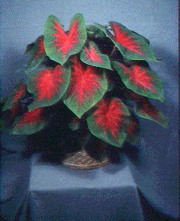
Caladiums
by Derek Burch
If ever a crop could be seen as foolproof, both for the nursery and in the landscape, that plant would surely be the caladium.
Let's look at them in turn from the point of view of the producer, and of the gardener.
1. Commercial Production
| Caladiums, with their brightly colored fancy or lanceolate leaves and tolerance to both heat and shade, make ideal landscape and container-grown plants for spring, summer and fall sales. They can be grown in small 3- and 4-inch pots for bedding plant sales, in 4- to 8-inch pots for house and patio plants, in 8- to 10-inch hanging baskets as accent plants, or in 12- to 16-inch garden baskets for eye-catching specimen plants. |
 |
Caladiums can be a "quick crop" for producers, provided that the plants are grown within the following guidelines:
1. Always know when the tubers were dug, as the tubers require an 8 week storage period after digging before they will grow.
2. Make sure tubers have been stored and shipped at temperatures above 70° F. Soft, rubbery tubers indicate cold damage and tubers will not grow properly.
3. De-eye the tubers (removal of a very small central portion of the dominant buds) to produce more, although smaller, leaves, and yield a fuller plant. Some cultivars (including Candidum Jr. and Florida Sweetheart) do not need this treatment, and the smaller leaves may not be desirable in large pots or some landscape situations.
4. Plant tubers upright in a well-drained, moist medium with a high organic content for moisture retention and a pH of 5.5 to 6.5. Cover the tubers with 1.5 to 2 inches of medium, since roots develop on the upper surface of the tubers.
5. Fertilize tubers with a liquid feed program of 400 ppm N-P-K weekly after first leaves appear or incorporate 1 lb N/cu yd of a slow release fertilizer in the medium.
6. Most cultivars produce optimum growth and color at 2,500 to 5,000 ft-candles of light.
7. Grow plants at 70-90° F with high humidity and never let plants dry to the wilting point.
8. Plants are generally marketable 5 to 8 weeks after planting, depending upon the pot and tuber size used. The time needed is reduced as the heat of summer comes into play.
9. Tuber sizes (by diameter) used for containers are:
#2 0.75 to 1.5 inches
#1 1.5 to 2.5 inches
Jumbo 2.5 to 3.5 inches
Mammoth 3.5 inches and up
10. Number of tubers used per container:
4" pot 1 or 2 #2’s; 1 #1 tuber
6" pot 5 to 6 #2’s; 3 #1’s; 1 to 2 Jumbo tubers
10" pot (pan) 10 to 12 #2’s; 5 to 6 #1’s; 3 to 4 Jumbo tubers
10" hanging baskets 10 to 12 #2’s; 5 to 6 #1’s; 3 to 4 Jumbo tubers
11. Caladiums generally have no foliar disease problems, but insect pests can include armyworms and loopers, aphids, mealy bugs and occasionally mites. These can be controlled using labeled products, but try to avoid emulsifiable concentrate formulations.
12. Plants should be shipped at temperatures at or above 70° F and retailers must be educated about the cold sensitivity of the plants and their need for lots of water.
Any nursery looking for a good hot-weather crop should try caladiums. Their diversity of color and leaf types make a colorful addition to spring and summer pot sales and also are a welcome addition to dry-bulb sales in retail outlets.
Dr. Michelle Bell and Dr. Gary Wilfret of the University of Florida Gulf Coast Agricultural Research and Education Center, Bradenton, FL provided the information and illustrations for these stories.
On to Caladiums in the Landscape
Back to Table of Contents